Gated community
In its modern form, a gated community (or walled community) is a form of residential community or housing estate containing strictly controlled entrances for pedestrians, bicycles, and automobiles, and often characterized by a closed perimeter of walls and fences. Similar walls and gates have separated quarters of some cities for centuries. Gated communities usually consist of small residential streets and include various shared amenities. For smaller communities, these amenities may include only a park or other common area. For larger communities, it may be possible for residents to stay within the community for most daily activities. Gated communities are a type of common interest development, but are distinct from intentional communities.
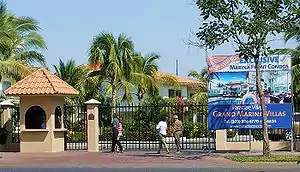
Given that gated communities are spatially a type of enclave, Setha M. Low, an anthropologist, has argued that they have a negative effect on the net social capital of the broader community outside the gated community.[1] Some gated communities, usually called guard-gated communities, are staffed by private security guards and are often home to high-value properties, and/or are set up as retirement villages. Some gated communities are secure enough to resemble fortresses and are intended as such.
Features
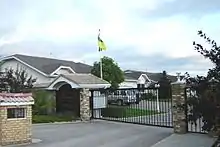
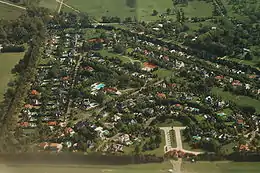
Besides the services of gatekeepers, many gated communities provide other amenities. These may depend on a number of factors including geographical location, demographic composition, community structure, and community fees collected. When there are sub-associations that belong to master associations, the master association may provide many of the amenities. In general, the larger the association the more amenities that can be provided.
Amenities also depend on the type of housing. For example, single-family-home communities may not have a common-area swimming pool, since individual home-owners have the ability to construct their own private pools. A condominium, on the other hand, may offer a community pool, since the individual units do not have the option of a private pool installation.
Typical amenities offered can include one or more:
Around the world
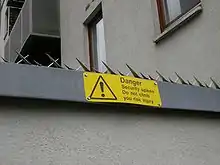
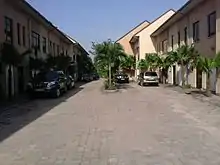
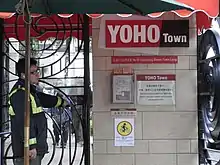
In Brazil, the most widespread form of gated community is called "condomínio fechado" (closed housing estate) and is the object of desire of the upper classes. Such a place is a small town with its own infrastructure (reserve power supply, sanitation, and security guards). The purpose of such a community is to protect its residents from exterior violence. The same philosophy is seen on closed buildings and most shopping centres (many of them can only be accessed from inside the parking lot or the garage).
In Pakistan, gated communities are located in big as well as small cities and are considered the standard of high quality living. Defence Housing Authority[2] and Bahria Town[3] are major private gated community developers and administrators and one of the largest in the world. The assets of Bahria Town itself are worth $30 billion.[4] Most gated communities in Pakistan[5] have public parks, schools, hospitals, shopping malls, gymnasiums, and country clubs.[6]
In Argentina, they are called "barrios privados" (literal translation "private neighborhoods") or just "countries" and are often seen as a symbol of wealth. However, gated communities enjoy dubious social prestige (many members of the middle and upper middle class regard gated community dwellers as nouveaux riches or snobs[7]). While most gated communities have only houses, some bigger ones, such as Nordelta,[8] have their own hospital, school, shopping mall, and more.
In post-segregation South Africa, gated communities have mushroomed in response to high levels of violent crime. They are commonly referred to as "complexes" but also broadly classified as "security villages" (large-scale privately developed areas) or "enclosed neighborhoods .[9] Some of the newest neighborhoods being developed are almost entirely composed of security villages, some with malls and few other essential services (such as hospitals). In part, property developers have adopted this response to counter squatting, which local residents fear due to associated crime, and which often results in a protracted eviction process.
They are popular in southern China, namely the Pearl River Delta Region, the most famous of which is Clifford Estates.
In Saudi Arabia, gated communities have existed since the discovery of oil, mainly to accommodate families from Europe or North America. After threat levels increased from the late 1990s on against foreigners in general and U.S. citizens in particular , gates became armed, sometimes heavily, and all vehicles are inspected. Marksmen and Saudi Arabian National Guard armored vehicles appeared in certain times, markedly after recent terrorist attacks in areas near-by, targeting people from European or North American countries.
Gated communities are rare in continental Europe and Japan.
Criticism
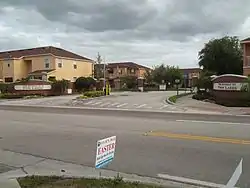
Proponents of gated communities (and to a lesser degree, of cul-de-sacs) maintain that the reduction or exclusion of people who would be only passing through, or more generally, of all non-local people, makes any "stranger" much more recognisable in the closed local environment, and thus reduces crime danger. Since only a very small proportion of all non-local people passing through the area are potential criminals, increased traffic should increase rather than decrease safety by having more people around whose presence could deter criminal behaviour or who could provide assistance during an incident.[10]
Another criticism is that gated communities offer a false sense of security. Some studies indicate that safety in gated communities may be more illusion than reality and that gated communities in suburban areas of the United States have no less crime than similar non-gated neighborhoods.[11]
A commentary in The New York Times specifically blames the gated communities for the shooting death of Trayvon Martin as the columnist states that "gated communities churn a vicious cycle by attracting like-minded residents who seek shelter from outsiders and whose physical seclusion then worsens paranoid groupthink against outsiders."[12]
In an influential paper, Vanessa Watson includes gated communities within a class of "African urban fantasies": attempts to remake African cities in the vein of Dubai or Singapore. In Watson's analysis, this kind of urban planning prizes exclusionary and self-contained spaces that limit opportunities for interaction between different classes, while worsening marginalization of the urban poor.[13]
A study done by Breetzke, Landman & Cohn (2014) had investigated the effect of gated communities on individual's risk of burglary victimization in South Africa. Results shown that not only are gated communities not able to reduce burglary, but even facilitate criminal activities. For both the gated communities and the areas surrounding them, the densities of burglary were found to be four times higher than that of Tshwane. The crime rates did not decrease in areas that were far away from the gated communities. Also, the high risk of burglaries was found consistent in both daytime and night-time. As this research on the effect of gated communities in South Africa reflects a negative correlation between the use of gated communities and crime prevention, the effectiveness of gated communities is in doubt.[14]
Common economic model types
- Life-style — country clubs, retirement developments.
- Prestige — gates for status appeal
- Physical security communities — gates for crime and traffic.
- Purpose-designed communities — catering to foreigners (e.g. worker compounds in Mid-West Asia, built largely for the oil industry)
Comparison to closed cities
The closed cities of Russia are different from the gated communities.
- The guard duty in closed cities is free to residents (paid by taxes).
- The public transport in closed cities may go with transit checkpoints or checking passes/passports at technical stops and available to others outside the security area. Within a gated community in the best cases, the bus stop is opposite the checkpoint; a few offer free buses. Via gated communities buses go due to easement or good will.
- Fares and communal payment in closed cities are often equal (in all cases not greater) if it would be a common city. In gated communities service companies raise non legally fixed tariffs because it is difficult for those communities either to negotiate lower terms or knock out this service company (in most cases the result is no quorum).
Examples
A limited number of gated communities have long been established for foreigners in various regions of the world:
- The worker compounds in the Middle East, built largely for the oil industry.
- The Arbor Oaks subdivision located in El Monte, California, which appears in the film Back to the Future Part II as "Hilldale", is now gated because of the fans coming to see it in person. Residents are sometimes angry at fans who come by the development.
Argentina
There are many gated communities in Argentina, especially in Greater Buenos Aires, in the suburb of Pilar, 60 km N of Buenos Aires city, and in other suburban areas, such as Nordelta.[8] Tortugas Country Club was the first gated community developed in Argentina, dating from the 1930s/1940s, but most date from the 1990s, when liberal reforms were consolidated.
Since Buenos Aires has been traditionally regarded as a socially integrated city, gated communities have been the subject of research by sociologists. Gated communities are an important way through middle and upper-class people cope with the high levels of violent criminal activity in Greater Buenos Aires.[15]
Australia
Although gated communities have been rare in Australia, since the 1980s, a few have been built. The most well-known are those at Hope Island, in particular Sanctuary Cove, on the Gold Coast of Queensland. Other similar projects are being built in the area. In Victoria, the first such development is Sanctuary Lakes, in the local government area of Wyndham, about 16 km south west of Melbourne. In New South Wales, there is Macquarie Links gated community[16] as well as Southgate Estate gated community. Many Australian gated communities are built within private golf courses.
In the ACT, the only example is Uriarra Village, based around community horse paddocks and dwellings jointly managed through strata title.
Brazil
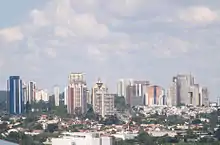
Brazil also has many gated communities, particularly in the metropolitan regions Rio de Janeiro and São Paulo. For example, one of São Paulo's suburbs, Tamboré, has at least 6 such compounds known as Tamboré 1, 2, 3, and so on. Each consists of generously spaced detached houses with very little to separate front gardens.
One of the first big-scale gated community projects in São Paulo city region was Barueri's Alphaville, planned and constructed during the 1970s military dictatorship when the big cities of Brazil faced steep increases of car ownership[17] by the middle and higher-classes, rural exodus, poverty,[18] crime, urban sprawl, and downtown decay.
Canada
Neighbourhoods with "physical" or explicit gating with security checkpoints and patrols are extremely rare, being absent in even some of Canada's richest neighbourhoods such as Bridle Path, Toronto. Furthermore, municipal planning laws in many Canadian provinces ban locked gates on public roads as a health issue since they deny emergency vehicles quick access.
A noted exception in Canada is Arbutus Ridge, an age-restricted community constructed between 1988 and 1992 on the southeastern coast of Vancouver Island.
More common in most Canadian neighbourhoods, especially the largest cities, is an implicit or symbolic gating which effectively partitions the private infrastructure and amenities of these communities from their surrounding neighbourhoods. A classic example of this is the affluent Montreal suburb of Mount Royal, which has a long fence running along its side of L'Acadie Boulevard that for all intents and purposes separates the community from the more working-class neighbourhood of Park Extension.[19] Also, many newer suburban subdivisions employ decorative gates to give the impression of exclusivity and seclusion.[20]
China
In China, some of these compounds, like most other gated communities around the world, target the rich. Also many foreigners live in gated communities in Beijing. Often foreign companies choose the locations where their foreign employees will live, and in most cases, they pay the rent and associated costs (e.g. management fees and garden work).
Similar communities exist in Shanghai, another major Chinese city. Shanghai Links, an exclusive expatriate community enclosing a golf course and the Shanghai American School, is an example. Other notable gated communities in Shanghai include Seasons Villas, a development by Hutchinson Whampoa, Thomson Golf Villas, and Green Villas.
Other gated communities in China such as those in the Daxing District of Beijing enclose the homes of rural migrants. These are intended to reduce crime and increase public order and safety, which the Communist Party of China-run People's Daily claims it has, by 73%. The system is controversial as it segregates migrants and the poor, with some claiming its true purpose is to keep track of migrants, but it is scheduled for implementation in Changping District also.[21]
Ecuador
Guayaquil and Quito, Ecuador have many gated communities. In the coastal city of Guayaquil, they are mostly located in Samborondón and in Quito in the valleys surrounding the city. They are home mostly for the wealthiest people, but there is a trend, especially in Guayaquil, of houses in gated communities with moderate prices as well.
Egypt
In Greater Cairo, for example, there is Dreamland, Mountain View Egypt, and in Alexandria, there is el Maamoura.
India
In India, there are many gated neighborhoods (also called "colonies" in New Delhi) in big cities where most of the upper middle-class and upper-class people live. New Delhi, Mumbai, Chennai, Bangalore and the like all have gated communities. Sometimes these communities are separated not just by wealth but also by ethnicity. There are colonies in New Delhi based on profession also like Press Enclave, set up by journalists in 1970s'. Members of a particular ethnicity tend to feel more comfortable living among their own owing to reasons related to common festivals, language, and cuisine. Examples of this are common in New Delhi where there is a strong Punjabi community. Many gated neighborhoods are predominantly Punjabi and there have been cases of discrimination against members of other ethnic backgrounds living in those communities. Likewise, there also exist Bengali, South Indian, Muslim, and Gujarati neighborhoods. Nowadays many modern gated communities are being developed like the Aamby Valley City and Lavasa City in Maharashtra occupying 100 square kilometers of area. Now gated communities are being built in Chennai, Hyderabad, Bangalore by a lot of real estate developers. As in neighboring countries, the target for these housing societies seem to be upper-middle or upper class citizens. Caste and religious discrimination is prevalent in the real estate industry. Several people have been denied homes based on their caste or religion. Nonetheless, non-residential Indians (foreigners of Indian origin) are very interested in gated housing.[22]
Indonesia
In Indonesia, some gated communities are luxurious (with up to 740 square metres (8000 sq ft)), and some are very affordable (with lots ranging from 40 to 120 square metres). From 2000, most of the new residential area built by private developers are gated community. Examples include Bumi Serpong Damai in South Tangerang, Telaga Golf Sawangan and Pesona Khayangan in Depok, and Sentul City in Bogor Regency. Gated communities in Indonesia still allow outsiders to use some of the facilities inside the community because there is a regulation that the social facilities in the residential development should be handed to the local government to be used by the public.[23]
Italy
Two examples of gated community in Italy are Olgiata in Rome and the village of Roccamare, in Castiglione della Pescaia, Tuscany.[24]
Lebanon
Because of the pollution, the lack of proper infrastructure, electrical power and green spaces in residential areas outside of Beirut, the high class society chooses to reside in gated communities for a better living environment.
Gated communities in Lebanon are mainly in the suburbs of the capital city Beirut. Some examples of gated communities are BelHorizon Village and Admir in Keserwan, and BeitMisk in the Matn District.[25][26]
Malaysia
In Malaysia, these are known as Gated and Guarded Communities and have been seeing a steady increase in popularity.[27] Currently, according to the Town and Country Planning Department, there are four types of gated communities in Malaysia, namely:
- Elite community: this type of gated community is primarily occupied by the upper-class or high-income group of people. It focuses on exclusion and status in which security is one of the major concerns due to the resident's status within the community.
- Lifestyle community: the lifestyle community generally consists of retirement communities, leisure communities and suburban ‘new towns’. Activities inside these communities can include golf courses, horseback riding and residents-oriented leisure activities.
- Security zone community: the security zone community is the most popular type of gated community in which it offers a housing development that is surrounded by fences or gates. This development is normally provided with guard services.
- Security zone community and lifestyle: this type of gated community housing development is usually developed within a city centre. It focuses on both the security aspect and the provision of lifestyle facilities for its residents.
The gated community is a concept that emerged in response to the rise of safety and security issues, and offers more advantages in terms of a calm environment and enhanced safety that is ideal for family development.[28]
Mauritius
Several gated communities now exist on the island of Mauritius since the government introduced Integrated Resort Schemes (IRS) and Real Estate Schemes (RES) in the mid 1990s. Recently they have been amalgamated into Property Development Schemes (PDS).[29] The government also introduced Smart City permits and in 2016 it secured the assistance of Saudi Arabia to launch the government's version of a gated Smart City known as Heritage City Project which was proposed at Minissy, in the region of Ebène, with the assistance of Saudi Arabia.[30]
Mexico
Gated communities in Mexico are a result of the huge income gap existing in the country. A 2008 study found that the average income in an urban area of Mexico was $26,654, a rate higher than advanced regions like Spain or Greece while the average income in rural areas (sometimes just a short distance away) was only $8,403. This close a proximity of wealth and poverty has created a large security risk for Mexico's middle class. Gated communities can be found in virtually every medium and large-sized city in Mexico with the largest found in major cities, such as Monterrey, Mexico City or Guadalajara.
Luxury or "status" gated communities are very popular with middle to high income residents in Mexico. Gated luxury communities in Mexico are considerably cheaper than in countries such as the United States while retaining houses of similar size and quality due to the commonness of the communities and the lower cost to build them and are priced lower to attract middle class residents.
Many gated communities in Mexico have fully independent and self-contained infrastructure, such as schools, water and power facilities, security and fire forces, and medical facilities. Some of the larger gated communities even retain their own school districts and police departments. The Interlomas area of Mexico City contains hundreds of gated communities and is the largest concentration of gated communities in the world, stretching over 140 square kilometres (54 sq mi). The surrounding areas of Santa Fe, Bosques-Lomas, Interlomas-Bosque Real, are also made up predominantly of gated communities and span over 30% of Greater Mexico City.
Many smaller gated communities in Mexico are not officially classified as separate gated communities as many municipal rules prohibit closed off roads. Most of these small neighborhoods cater to lower middle income residents and offer a close perimeter and check points similar to an "authentic" gated community. This situation is tolerated and sometimes even promoted by some city governments due to the lack of capacity to provide reliable and trusted security forces.[31]
New Zealand
In New Zealand, gated communities have been developed in suburban areas of the main cities since the 1980s and 1990s.[32][33]
Pakistan
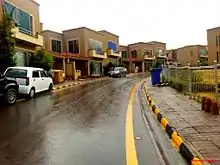
Pakistan has a very large number of gated communities, most of which target middle class Pakistanis. The largest being Bahria Town, which is also the largest in Asia and has communities in major cities. Defence Housing Authority is also a major developer of gated communities.
Others include WAPDA Town, Gulberg, Islamabad and Schon Properties, while Emaar Properties also maintains several gated communities in the country targeting primarily upper class people. Gated communities in Pakistan are mostly immune from problems of law enforcement and lack of energy faced by the majority of the other housing societies. In a short time, the property prices in such communities have greatly increased – in 2007 a 20-square-meter house in Bahria Town, Lahore cost around four million rupees ($40,000); a similar property in 2012 costed nine million rupees, while houses are priced around 100-300 million rupees.
Peru
Lima, Peru has several gated communities, especially in the wealthy districts of La Molina and Santiago de Surco. They are home to many prominent Peruvians.
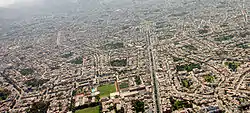
Philippines
The Philippines has a sizable number of gated communities which are known in Philippine English as "subdivisions" or "villages". Regardless of their names, such communities may either form part of a larger barangay (village), or constitute a single barangay in and of themselves.
Russia
Aerobus live complex[34] is the de facto first gated community in Moscow. Business center is in this complex but outside the residential area.
Ozero is a cooperative formed around Vladimir Putin's dacha on Lake Komsomolskoe (Finnish: Kiimajärvi), Priozersky District, Leningrad Oblast.
Saudi Arabia
In Saudi Arabia, many expatriate workers are required to live in company-provided housing. After the 2003 attack on Al Hambra, Jadawel, Siyanco and Vinell by militant Saudi dissidents,[35] the government established tight military security for those compounds with large western populations. Many western individuals also reside in the many other gated compounds or non-gated villas and apartments in the cities that they work. Saudi Aramco provides a compound in Dhahran which is one of the largest of its kind within Saudi Arabia. Gated communities are also popular with many Saudis, which accounts for the limited availability of open villas in these communities and the premium rent paid for that housing. These compounds can be found in many of Saudi Arabia's cities, including but not limited to Abha, Dhahran, Riyadh, and Taif.[36]
Singapore
Sentosa Cove is the only gated residential community in Singapore. It is a bunch of private houses specially built for the super-rich in Singapore.
South Africa
South Africa has an increasing number of gated communities, where the wealthy sometimes live in close proximity to the urban poor (yet with little contact between the two).[37]
Thailand
Many housing estates in Thailand take the form of gated communities, targeted to the upper and middle classes. They may be managed by the development company or by resident committees.
Gated communities are often referred to as mubans in Thailand.[38]
Turkey
Turkey has several gated communities, especially in Istanbul and Ankara. Called "site" in Turkish, they are mostly located around the edge of the city.
United Arab Emirates
In the United Arab Emirates, gated communities have exploded in popularity, particularly in Dubai, where the 2002 decision to allow foreigners to own freehold properties has resulted in the construction of numerous such communities built along various themes. Examples include The Lakes, Springs, Meadows, and Arabian Ranches.
United Kingdom
In the United Kingdom, gated communities are relatively rare. In 2004 there were an estimated 1,000 such communities in England (i.e. not including Scotland, Wales and Northern Ireland). They are usually on a small scale: a gated street of up to 60 or 100 houses, or a single block of up to 500 or 700 flats. They can be found in London, for example, in the Docklands (such as New Caledonian Wharf, Kings and Queen Wharf and Pan Peninsula) and East London (such as Bow Quarter in Bow, London).[39]
United States
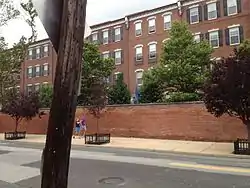
Most gated communities in the US are unincorporated: some, like Indiana's Briar Ridge, may even span more than one incorporated municipality. However, there are numerous incorporated gated cities in Southern California, namely Bradbury, Canyon Lake, Hidden Hills, Laguna Woods, and Rolling Hills.[40] To meet legal requirements, the city halls and municipal facilities are public, and private corporations own parks and other facilities within the gates. By 1997, an estimated 20,000 gated communities had been built across the country.[41] Approximately 40% of new homes in California are behind walls.[42] In 1997, estimates of the number of people in gated communities ranged from 4 million in 30,000 communities[43] up to around 8 million, with a 1⁄2 million in California alone.[44] One reason that it is difficult to determine how many gated communities are in the United States is that most are privately developed.[45]
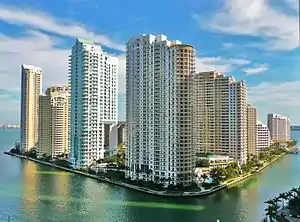
There are other incorporated gated communities outside California, including Lake Quivira, Kansas, Sea Ranch Lakes, Florida, Anderson Creek, North Carolina, and North Oaks, Minnesota.
Smoke Rise was one of the earliest private gated community club plans in the United States. It encompasses more than 900 unique homes located on 2,500 acres (1,000 ha) in addition to Lake Kinnelon, it is an upscale gated community in Kinnelon, New Jersey that was created out of the estate of Francis Kinney, a 19th-century industrialist who founded Kinney Brothers Tobacco Company.[46] Located in the north woods of New Jersey the gated lakeside community provides 24-hour Security, activities, clubs and special events grounded in a tradition of community spirit and service. The community was conceived and based on a dual philosophy that no two homes would look alike with a minimum size of 2,500 square feet located on a one and a half acre wooded lot.[47]
Hot Springs Village, Arkansas is the largest gated community in the United States with over 26,000 heavily wooded acres. Hot Springs Village is governed by the Hot Springs Village Property Owners' Association (or POA for short), a private, tax-exempt home owners association. Bay Harbor, Michigan is the largest gated community in the Midwestern United States.
The village of Rosemont, Illinois, just outside Chicago, maintains a security checkpoint at the entrance of its main residential section. Naval Square was the first in the city of Philadelphia, Pennsylvania. The neighborhood gives a suburban feel to an otherwise urban environment.
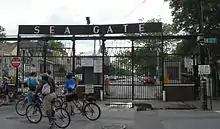
In Downtown Miami, Florida, the neighborhood of Brickell Key is a gated island community of high-rise residential towers. Although anyone can walk onto the island or come via the public bus, only authorized automobiles may enter. Brickell Key has some of the most expensive apartments in Miami.
In 2012, the gated community The Retreat at Twin Lakes was made famous by the shooting of Trayvon Martin by George Zimmerman and has been in the national spotlight well into the year 2013 with the acquittal of Zimmerman.
In popular media
In television
(Alphabetical by series title)
- In the cartoon As Told By Ginger, the Griplings reside in Protective Pines.
- In The Neighbors, a 2012 TV series in the United States, a family has relocated to a gated townhouse community called "Hidden Hills" in New Jersey only they discover that the entire community is populated by residents from another planet who identify themselves by the names of sport celebrities, patrol the community in golf carts, receive nourishment through their eyes and mind by reading books rather than eating, and cry green goo from their ears.
- In Safe, a Netflix original series based on a mystery in and around a gated community.
- In the SpongeBob SquarePants episode "Squidville", Squidward Tentacles temporarily moves to a gated community of squids to get away from SpongeBob SquarePants and Patrick Star.
- The Bravo network reality television series The Real Housewives of Orange County was initially set primarily in the gated community of Coto de Caza, California ("Coto") and followed the lavish livestyles of "housewives" and their families who resided within Coto. One housewife, Lauri Waring, who lived in a Ladera Ranch townhouse, was the exception-to-the-rule that was used as a foil to the extravagant lifestyle of the other four housewives, who lived "behind the Coto gates".
- Most of The Starter Wife miniseries is set within the gated community where the main character's friend lives. She even becomes friends with the security guard at the front gate.
- The pilot episode of the 2002 revival of The Twilight Zone titled "Evergreen" deals with a gated community called Evergreen Estates which has a sinister way of dealing with nonconformity that involves rebellious children committing those acts being taken to "Arcadia Fertilizer Company" where they are executed and made into red fertilizer for the small trees in front of the houses there.
- In one episode of VeggieTales (Sherlock Holmes and the Golden Ruler), Larry sings a song about gated communities in Silly Songs with Larry.
- In seasons 1-3 of Weeds, Nancy Botwin and her family inhabit the gated community of Agrestic.
- In The Gates, a 2010 cancelled TV series, Nick Monohan and his family move from Chicago to a quiet, upscale planned community called The Gates, where he will be chief of police. They soon realize that their neighbors are not who they seem to be. The Gates is filled with such beings as vampires, witches, werewolves, and a succubus.
- In the Season Six episode of The X-Files entitled "Arcadia", Mulder and Scully investigate disappearances within a gated community that seems to be harboring a terrible secret.
In film
- Mexican film La Zona, directed by Rodrigo Plá, talks about a gated community invaded by a group of very young and poor children.
- In the ABC Family movie Picture This starring Ashley Tisdale, Drew lives in a gated community called Camelot.
- In the Spanish movie Secuestrados, kidnappers take the daughter of a family living in an allegedly secure gated community.
- In the 2007 animated movie Alvin and the Chipmunks, the chipmunks and their guardian Dave Seville live in a gated community.
In games
- Grand Theft Auto IV has a gated community called Beachgate, a fictional rendition of Sea Gate, Brooklyn. It includes the home of early antagonist Mikhail Faustin.
In songs
- In "Versace", Drake says: "This is a gated community please get the fuck off the property"–referring to the gated community of Hidden Hills, California.
In comics
- Early in The Walking Dead comic book series, Rick Grimes attempts to settle in a gated condominium neighborhood. This move proves disastrous as one of the group members is killed after the survivors realize the neighborhood is infested with zombies.[48]
In literature
(Alphabetical by author's last name)
- In Margaret Atwood's novel Oryx and Crake, the characters Snowman and Crake live and work in corporate-owned gated communities known as compounds.
- J.G. Ballard has examined the phenomenon in his novella Running Wild (1988) and in his novel Super-Cannes (2000).
- T.C. Boyle's novel The Tortilla Curtain (1995) is set in and near a gated community in California.
- The novel Parable of the Sower, by Octavia Butler, takes place in a world where much of civilization lives within gated communities.
- In the novel I Will Fear No Evil by Robert A. Heinlein, the wealthiest citizens shelter from urban poverty inside fortress-like guarded gated communities.
- Ira Levin's novel The Stepford Wives (1972) takes place inside an idyllic gated community that secretly enslaves its female members to conform to the standards of the men.
- In the Percy Jackson & the Olympians and The Heroes of Olympus series by Rick Riordan, Elysium is depicted as a gated community from which one could hear laughter and smell barbecue cooking. Besides having the Isle of the Blessed in the center of a large lake there, Elysium has neighborhoods of beautiful houses from every time period in history such as Roman villas, medieval castles, and Victorian mansions. It also has flowers of silver and gold blooming on the lawns and grass rippling in rainbow colors.
- In Argentina, Claudia Piñeiro's Las viudas de los jueves (Thursday Widows) became a local bestseller after winning the 2005 edition of El Clarín newspaper book award.[49] The novel depicts life of dwellers of a gated community, among them, families who enjoyed high incomes now facing economic hardships.
- In Egypt, Ahmed Khaled Towfik's novel Utopia takes readers on a chilling journey beyond the gated communities of the North Coast where the wealthy are insulated from the bleakness of life outside the walls.
- In the novel Snow Crash (1992) by Neal Stephenson, gated communities have evolved into "burbclaves" (suburban enclaves) which are effectively sovereign city-states.
See also
References
- "Low, S (2001) The Edge and the Center: Gated Communities and the Discourse of Urban Fear, American Anthropologist, March, Vol. 103, No. 1, pp. 45-58 Posted online on December 10, 2004." www.anthrosource.net
- Karachi, MIS Dte, DHA. "Pakistan Defence Officers Housing Authority,Karachi". dhakarachi.org. Retrieved 16 September 2017.
- "Home - Bahria Town - Your Lifestyle Destination". bahriatown.com. Retrieved 16 September 2017.
- "Bahria Town Today". Bahria Town Today. Retrieved 16 September 2017.
- "HOME". Retrieved 16 September 2017.
- "New Projects - Ghar47". Retrieved 16 September 2017.
- Clarín.com. ""Las viudas de los jueves", un retrato feroz y preciso de la Argentina".
- "Nordelta". Archived from the original on 20 June 2007. Retrieved 16 September 2017.
- "Archived copy" (PDF). Archived from the original (PDF) on 2012-03-05. Retrieved 2010-06-05.CS1 maint: archived copy as title (link)
- Can Streets Be Made Safe? - Hillier, Bill; Bartlett School of Graduate Studies, University College London
- Blakely, E.J., and M.G. Snyder (1998), "Separate places: Crime and security in gated communities." Archived 2017-12-15 at the Wayback Machine in: M. Felson and R.B. Peiser (eds.), Reducing crime through real estate development and management, pp. 53-70. Washington, D.C.: Urban Land Institute.
- Benjamin, Rich (29 March 2012). "The Gated Community Mentality". Internet Archive. Archived from the original on 1 April 2012. Retrieved 23 October 2017.
- Watson, Vanessa (2013-12-06). "African urban fantasies: dreams or nightmares?". Environment and Urbanization. 26 (1): 215–231. doi:10.1177/0956247813513705. ISSN 0956-2478. S2CID 154398313.
- Breetzke, Gregory D.; Landman, Karina; Cohn, Ellen G. (2013-06-23). "Is it safer behind the gates? Crime and gated communities in South Africa". Journal of Housing and the Built Environment. 29 (1): 123–139. doi:10.1007/s10901-013-9362-5. ISSN 1566-4910. S2CID 54601558.
- "Seguridad, un factor decisivo". 2008-06-14. Retrieved 16 September 2017.
- "Behind the urban curtains". The Sydney Morning Herald. March 4, 2005.
- Middle-Class Wheels, TIME Magazine, December 6, 1968
- A Decade of Ditadura, TIME Magazine, March 25, 1974
- Kristian Gravenor. "Segregation fence to live on". Archived from the original on 2012-07-01.
- "research network: private urban governance "gated communities", "business improvement districts", "homeowner associations", "planned unit developments"". www.gated-communities.de. Retrieved 16 September 2017.
- "Migrant ‘Villages’ Within a City Ignite Debate" article by Helen Gao in The New York Times October 3, 2010. Retrieved October 4, 2010.
- "NRIs Showing Renewed Interest in Indian Real Estate: HDFC - NDTV". Retrieved 16 September 2017.
- Asiz, Rangi Faridha (2008). Fenomena Gated Community di Perkotaan (PDF) (Thesis) (in Indonesian). University of Indonesia. p. 101.
- Barbara Catalani; Marco Del Francia; Giovanni Tombari (2011). Itinerari di architettura contemporanea. Grosseto e provincia. Pisa: ETS. pp. 24–25.
- http://www.belhorizoncountryclub.com/situation.htm
- https://beitmisk.com/beitmisk/
- "Gated & Guarded homes – trend or necessity?". Retrieved 16 September 2017.
- "Gated & Guarded: Boon or Bane" article by Rakesh Kumar in www.iproperty.com Mar 04, 2013. Retrieved November 25, 2013.
- "Call to stop Gated Communities, Smart Cities, Land Speculation". Lalit Mauritius. Retrieved 2016-06-15.
- "Heritage City at Ebene: USD 820 million project ready in 3 years". Le Défi. Retrieved 2016-01-29.
- "Gated communities in Mexico City" Archived 2011-06-28 at the Wayback Machine article by Angela Giglia Ciotta in Home Culture March 1, 2008. Retrieved July 17, 2011.
- Noted. "New Zealand Listener - Noted". Noted. Retrieved 16 March 2018.
- Taonga, New Zealand Ministry for Culture and Heritage Te Manatu. "7. – Suburbs – Te Ara Encyclopedia of New Zealand". www.teara.govt.nz. Retrieved 16 March 2018.
- 55.807757 37.545196
- "Saudi Arabia, Housing Available, 1, expatriates.com". www.expatriates.com. Retrieved 16 September 2017.
- Lemanski, Charlotte (February 2006). "Spaces of Exclusivity or Connection? Linkages between a Gated Community and its Poorer Neighbour in a Cape Town Master Plan Development". Urban Studies. 43 (2): 397–420. doi:10.1080/00420980500495937. ISSN 0042-0980. S2CID 154804831.
- "Living inside a Moo Baan". rentbangkokcondos.com. 25 April 2014. Retrieved 16 March 2018.
- "Gates and ghettoes: A tale of two Britains?". BBC. 18 March 2004. Retrieved 9 August 2017.
- Halper, Evan (May 28, 2002). "Communities Say Keep Out--by Bluffing". Los Angeles Times.
- Prevention of Crime: An Overview of Gated Communities and Neighborhood Watch Archived September 23, 2006, at the Wayback Machine
- El Nasser, Haya (December 15, 2002). "Gated communities more popular, and not just for the rich". USA Today.
- Boaz, David, Libertarianism: A Primer, Free Press, p. 267
- John Jay College of Criminal Justice/CUNY (May 15, 1997), Gated Enclaves Are Not Just for the Well-Heeled, Law Enforcement News
- "Second Homes in Private Communities Sometimes Hidden Gems". PrivateCommunities.com. October 15, 2010. Retrieved 2011-11-04.
- Cheslow, Jerry. "If You're Thinking of Living In/Kinnelon, N.J.; Residential Life Amid Natural Beauty", The New York Times, June 1, 2003. Accessed August 21, 2012. "Ms. Dunner Parker knew the area through a brother who lived in Kinnelon's Smoke Rise section, a 3,500-acre, 900-home gated community that describes itself in its promotional literature as 'one of America's most prestigious club communities' and 'elite, yet affordable.' Covering the borough's northwestern quadrant, Smoke Rise's lots are heavily wooded and range in area from 1 to 10 acres, with the most valuable properties fronting on the 19-acre Lake Kinnelon."
- http://www.smokerise-nj.com/smokeriseclub/sub_category_list.asp?category=57&title=FAQs
- The Walking Dead #9 at the Comic Book DB (archived from the original) Retrieved Dec 23, 2011.
- Clarin.com. ""Las viudas de los jueves", un retrato feroz y preciso de la Argentina". www.clarin.com. Retrieved 16 September 2017.
Further reading
- Arizaga, Maria Cecilia: El Mito de comunidad en la Ciudad Mundializada. ISBN 987-9035-28-3
- [Arizaga, Maria Cecilia: Murallas y barrios cerrados, La morfología espacial del ajuste en Buenos Aires. Nueva Sociedad, 166, 2000 http://www.nuso.org/upload/articulos/2836_1.pdf]
- Blakely, Edward J. and Mary Gail Snyder; Fortress America: Gated Communities in the United States; Brookings Institution Press, New Ed edition (June 15, 1999); ISBN 978-0-8157-1003-5
- Gasior-Niemiec, Anna; Glasze, Georg and Pütz, Robert (2009): A Glimpse over the Rising Walls: The Reflection of Post-Communist Transformation in the Polish Discourse of Gated Communities. In: East European Politics & Societies 23 (2009) 2: 244–265.
- Glasze, Georg, Chris Webster and Klaus Frantz (2006): Introduction: global and local perspectives on the rise of private neighbourhoods. In: Georg Glasze, Chris Webster and Klaus Frantz (Eds.): Private Cities. Global and local perspectives. Routledge. London und New York: 1–8.
- Glasze, Georg (2003): Private Neighbourhoods as Club Economies and Shareholder Democracies. – In: BelGeo 1/2003 Theme Issue "Privatization of Urban Spaces in Contemporary European Cities": 87-98
- Libertun de Duren, Nora. "Planning à la Carte: The location patterns of gated communities around Buenos Aires in a decentralized planning context." International Journal of urban and regional research 30.2 (2006): 308-327.
- Low, Setha M: Behind the Gates: Life, Security and the Pursuit of Happiness in Fortress America. Routledge: New York and London: 2003.
- Webster, Chris, Georg Glasze und Klaus Frantz (2002): The global spread of gated communities. In: Environment and Planning B 29 (2002) 3: 315-320
External links
- Built Metaphors: Gated Communities and Fiction, by Stéphane Degoutin and Gwenola Wagon
- Gated communities as an urban pathology?, by Renaud Le Goix
- The Privatization of Urban Space: Gated Communities - A New Trend in Global Urban Development?
- Land Use and Design Innovations in Private Communities
- China's Transition at a Turning Point
- Forbes: Most Expensive Gated Communities In America 2004
- Fortress Bulgaria: gated communities
- Max Zirzow, Fran Espinoza and Jonas Janssen. 2012. “Gated Communities.” InterAmerican Wiki: Terms - Concepts - Critical Perspectives.